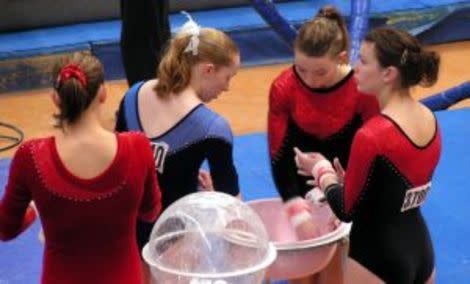Fun Facts About Gymnastics

Gymnastics are taken as part of a class, an after-school program, or first experienced in gym class. Many kids have had the shared experience of walking on a balance beam, tumbling, and spring boarding over a pommel horse. Gymnastics may be part of your life again, thanks to your daughter, son, niece, or an interest in the Olympics. Explore and share these fun facts about gymnastics.
Who invented the leotard?
The leotard is the gymnastics uniform. Leotards are comfortable, form-fitting, and they give gymnasts and dancers freedom of movement. The leotard is named after French acrobat Jules Leotard (1842-1870). He performed the first flying trapeze act on Nov. 12, 1859 while wearing a body-hugging costume.
Leotard called his costume a "maillot," French for jersey. It was more of a body stocking, complete with long sleeves and full legs. These body stockings were typically worn under clothes, but Leotard used the garment to show off his athletic physique. By 1886 the word leotard was commonly used to describe a skin-tight, legless garment, with or without sleeves. Although he did not invent the garment, which was already being worn under clothing, he did popularize it.
Why do gymnasts use chalk?
Gymnasts use chalk for a simple reason: to improve their grip. The chalk absorbs sweat, keeping hands dry. If hands are wet there could also be too much friction, which could create unwelcome and painful rips or blisters. Gymnasts on the parallel bars want just enough friction so their hands glide along the bars.
How old is Rhythmic gymnastics?
Although rhythmic gymnastics were not officially recognized as a sport until 1962, and not part of the Olympic Games until 1984, elements of the sport date back to 1904, according to "Nike is a Goddess: The History of Women in Sports." In 1904 women's gymnastics debuted at the Olympics.
The athletes wore long skirts and high collars. They used props, including clubs, canes, wands, ropes, and barbells in their group exercises. Today's rhythmic gymnasts use clubs, ropes, ribbons, and hoops. The sport can be traced back to Scandinavia during 19th century.
What makes women's gymnastics unique compared to other competitive women's sports?
Unlike women's softball or basketball, women's Olympic gymnastics is not simply men's gymnastics modified for women. It's different. "It takes advantage of the different body build of the female, and emphasizes grace, poise, and flowing movement rather than strength and power," according to author Kitty Kjeldsen.
Which U.S. female gymnast has three gymnastics moves named after her?
Buildings, schools, and highways are frequently named after famous people. Gymnasts are also honored this way. Except there aren't stationary objects bearing their name. Instead, their names are tacked onto difficult gymnastic moves.
Kelly Garrison lends her last name to three, separate gymnastics moves. Garrison is best known for inventing a move rated "super E," which is the hardest. Her famous move is the "round-off to the beat board and a back flip with a full twist landing with perfect balance onto a four inches wide beam," according to the U.S. Gymnastics Hall of Fame.
Sources
Peggy Shinn, "Gymnastics: Gone is the perfect 10," United States Olympic Team
"History of Rhythmic Gymnastics," USA Gymnastics
"Skills Named for U.S. Women," USA Gymnastics
Dr. Larry Banner, Biography: Garrison, Kelly , U.S. Gymnastics Hall of Fame
"History of the Leotard," GymnasticsLeotards4u
Kitty Kjedlson, "Women's Gymastics" Allyn and Bacon, Inc.
Liberty Academy of Rhythmic Gymnastics
U.S. Gymnastics Hall of Fame
The World of Aerial Dance
Lissa Smith, Editor, "Nike is a Goddess: The History of Women in Sports," Atlantic Monthly Press, New York, 1998
Content by Pam Gaulin.
